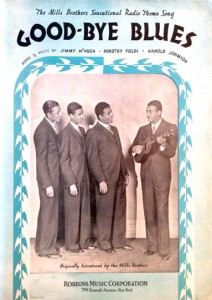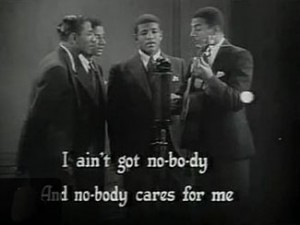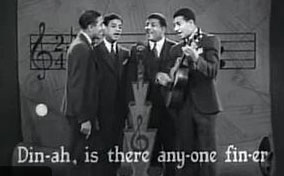 By 1931, the Max Fleischer “Screen Songs” cartoons were a certifiable success, both with theater-goers and with exhibitors.
By 1931, the Max Fleischer “Screen Songs” cartoons were a certifiable success, both with theater-goers and with exhibitors.
Fleischer’s idea to add animation to the old-fashioned song slides was a winner, even back in the days of silent pictures. With the addition of sound, they were even more popular.
Yet Max Fleischer, his brothers Dave and Lou, and the rest of the crew, were not allowing grass to grow underneath their feet.. They were always looking for new wrinkles–and they found one in adding live-action segments to the cartoons.
The decision was made, and Paramount Pictures saw that the idea had merit–it would allow the promotion of live appearances of various artists at Paramount-Publix theaters.
Over the next three years, a number of artists appeared in these cartoons. Some were already show-business legends (Eddie Cantor, the Watson Sisters),, while others were beginning careers that would make of them legends themselves (Ethel Merman, Rudy Vallee). Still others were names at the time, but their careers fell into the twilight zone of almost-forgotten entertainers (e. g. Stoopnagel and Budd, Singin’ Sam or Mary Small).
 One act that falls into the second category above not only did three Screen Songs cartoons, but displayed good humor when other studios had good-natured fun with caricature. That act was the Mills Brothers.
One act that falls into the second category above not only did three Screen Songs cartoons, but displayed good humor when other studios had good-natured fun with caricature. That act was the Mills Brothers.
I don’t need to go into the whole megilla of their bio – you can check their Wikipedia page for that.
Black vocal groups were pretty much under the radar of most folks. The last time such an ensemble made any noise in the general music scene was when the Fisk University Jubilee Singers made tour after tour back before the turn of the Twentieth Century.
When the Mills Brothers came out of Ohio-based vaudeville and radio, and hit Broadway in 1931, they came with a first-rate gimmick. They used their voices–and their cupped hands at times–to imitate a small orchestra, while one of them strummed a guitar.
This was a new sound, and CBS radio was smart to pick up on them right away. What’s more, they dressed neatly, and gave the impression that they acted right at all times–which was very important back in those days, regardless of one’s race!
And they were soon able to find sponsors who would pay or the privilege of being associated with the “four boys and a guitar” (a correct building, as some of them were still in their teens). These sponsors included Chipso (soap chips) and Crisco (shortening).
 The “boys” also signed with Brunswick Records, which added them to a catalog that included newly-discovered talents such as Bing Crosby and the Boswell Sisters. The labels reassured the listening public that “No musical instruments of mechanical devices” were used on the discs–apart from one guitar, which was acknowledged.
The “boys” also signed with Brunswick Records, which added them to a catalog that included newly-discovered talents such as Bing Crosby and the Boswell Sisters. The labels reassured the listening public that “No musical instruments of mechanical devices” were used on the discs–apart from one guitar, which was acknowledged.
A similar note appears on all three of the Max Fleischer “Screen Songs” cartoons–I Ain’t Got Nobody, Dinah and When Yube Plays The Rhumba On The Tuba. In fact, the boys provide almost all the music on these cartoons.
Manny Baer’s house orchestra does get in one fanfare at the beginning of “I Ain’t Got Nobody”, while a little additional instrumentation appears in the animated section of two of these cartoons–there is some drumming on “Nobody”, and a second guitar herd on the performance of “Nancy Lee” heard in the early part of “Dinah”.
 Many of the numbers that the Mills Brothers did–both on records, and for the soundtracks of these cartoons — were what musicians would call “evergreens”, or what Louis Armstrong would call “good ol’ good ones” — numbers that musicians liked to play when they were playing for their own enjoyment, and which the pubic liked to hear again and again.
Many of the numbers that the Mills Brothers did–both on records, and for the soundtracks of these cartoons — were what musicians would call “evergreens”, or what Louis Armstrong would call “good ol’ good ones” — numbers that musicians liked to play when they were playing for their own enjoyment, and which the pubic liked to hear again and again.
Two of the cartoons — I Ain’t Got Nobody and Dinah–are available in their entirety on YouTube and on DailyMotion. Dinah was recently restored by the UCLA Film and Television Archives. By contrast, for “Yuba”, only the animated sequences are available. This is too bad, because Herman Hupfeld’s song about a tubist who went to Cuba is one that the Mills Brothers did not record commercially–at least, not at the time.
Next Week: Some parodies, and speculations as to who did them.


 James Parten has overcome a congenital visual disability to be acknowledged as an expert on the early history of recorded sound. He has a Broadcasting Certificate (Radio Option) from Los Angeles Valley College, class of 1999. He has also been a fan of animated cartoons since childhood.
James Parten has overcome a congenital visual disability to be acknowledged as an expert on the early history of recorded sound. He has a Broadcasting Certificate (Radio Option) from Los Angeles Valley College, class of 1999. He has also been a fan of animated cartoons since childhood.











































Thanks for a great post. I appreciate that the Fleischers promoted the Mills Brothers through animation, and I wonder what might have been if the studio hadn’t abandoned African American musical stars for more Disney-esque cartoons by 1935.
Well– the Production Code probably helped to kill those wonderful Jazz Age cartoons by that time anyway.
i was so incredibly honored to have gotten to meet them, at the Blue Room (Roosevelt Hotel). It was a father-son high not to be topped!!!
I do know of at least two other acts that also relied on the vocal mimicry of musical instruments in whole or in part, from around the same time: the first was the German group The Comedian Harmonists, and the second were the Duncan Sisters.
A bit of footage from 1931 here shows the Harmonists, accompanied by a piano in the same way the Mills Brothers were on the guitar: https://www.youtube.com/watch?v=c9DFdBAwJds Not much of it in evidence, here, though you see a hint of it at 0:35.
You can hear the Duncan Sisters doing their version of that kind of performance here, in this 1930 Victor recording of “I’m Following You” https://www.youtube.com/watch?v=3ed2IIlrH48 at about 2:00, though of course there’s more of an orchestra backing them up, there.
Yes, and before the Comedian Harmonsts (a much-storied group), there was The Revelers, who were the inspiration for the German group.
Their version of “Bam Bam Bammy Shore” is illustrative of the arrangements that accompanist Ed. Smalle made for them. There are multiple uploads on YouTube, some from 78 rpm discs, some dubbed a little more slowly (around 76.59).
In regards to this article, who cares about the the Comedian Harmonists or the Duncan Sisters?! This is about the Mills Brothers and their contribution to post-Silent Era animation. If it was about boxer Joe Louis you would no doubt bring up Rocky Marciano. Geez!!!
And with any luck, the missing footage (live-action, natch) will finally be found somewhere from When Yuba Plays the Rumba on the Tuba,